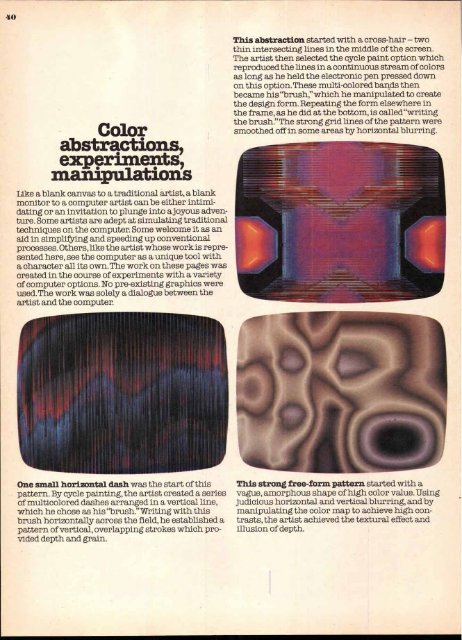Volume 9–3 (Low Res).pdf
Volume 9–3 (Low Res).pdf
Volume 9–3 (Low Res).pdf
You also want an ePaper? Increase the reach of your titles
YUMPU automatically turns print PDFs into web optimized ePapers that Google loves.
40<br />
Color<br />
abstractions,<br />
experiments,<br />
manipulations<br />
Like a blank canvas to a traditional artist, a blank<br />
monitor to a computer artist can be either intimidating<br />
or an invitation to plunge into a joyous adventure.<br />
Some artists are adept at simulating traditional<br />
techniques on the computer. Some welcome it as an<br />
aid in simplifying and speeding up conventional<br />
processes. Others, like the artist whose work is represented<br />
here, see the computer as a unique tool with<br />
a character all its own. The work on these pages was<br />
created in the course of experiments with a variety<br />
of computer options. No pre-existing graphics were<br />
used. The work was solely a dialogue between the<br />
artist and the computer.<br />
One small horizontal dash was the start of this<br />
pattern. By cycle painting, the artist created a series<br />
of multicolored dashes arranged in a vertical line,<br />
which he chose as his "brush." Writing with this<br />
brush horizontally across the field, he established a<br />
pattern of vertical, overlapping strokes which provided<br />
depth and grain.<br />
This abstraction started with a cross-hair — two<br />
thin intersecting lines in the middle of the screen.<br />
The artist then selected the cycle paint option which<br />
reproduced the lines in a continuous stream of colors<br />
as long as he held the electronic pen pressed down<br />
on this option. These multi-colored bands then<br />
became his "brush," which he manipulated to create<br />
the design form. Repeating the form elsewhere in<br />
the frame, as he did at the bottom, is called"writing<br />
the brush." The strong grid lines of the pattern were<br />
smoothed off in some areas by horizontal blurring.<br />
This strong free-form pattern started with a<br />
vague, amorphous shape of high color value. Using<br />
judicious horizontal and vertical blurring, and by<br />
manipulating the color map to achieve high contrasts,<br />
the artist achieved the textural effect and<br />
illusion of depth.

















